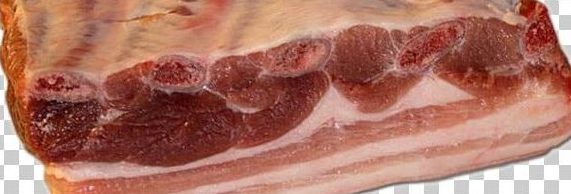Dietary fat consists mainly of triglyceride with varying amounts of free fatty acids and glycerol. Lipids can either be simple (triglycerides, wax) or complex (containing many other elements).
Triglycerides are divided into short, medium, and long chain based on the number of carbon atoms in the fatty acid chain. Essential fatty acids are long-chain fatty acids that cannot be synthesized in the body; most fatty acids consumed in the diet are long-chain fatty acids. Most nutrients consumed are digested and absorbed in the small intestines, where they then enter the blood supply via the portal vein and are delivered to the liver. When long-chain fatty acids are consumed, they are digested and absorbed into the small-intestinal epithelial cells; however, they are not transported directly into the blood supply but rather enter the lymphatics first. There are conflicting studies regarding the fate of dietary medium-chain fatty acids. Most studies suggest that medium-chain fatty acids do not require initial transport in the lymphatics and instead can be absorbed from the intestines directly into the blood supply via the portal vein.
Fatty acids are either saturated, indicating there are no double bonds, or unsaturated, indicating there are one or more double bonds. Fatty acids that contain more than one double bond are called polyunsaturated fatty acids (PUFA). PUFA are designated as either omega-3, omega-6, or omega-9 fatty acids, depending on the location of the first double bond. The more double bonds a fatty acid contains, the more prone it is to rancidity if not properly preserved. Saturated fatty acids are used primarily for energy in the body, whereas unsaturated fatty acids are found in cell membranes and blood lipoproteins.
Dietary fatty acid profiles are reflected in the fatty acid composition of tissues and cell membranes. In general, as the fat content of a diet increases, so does the caloric density and palatability, which promotes excess calorie consumption and obesity. Fat is a concentrated source of energy, yielding ~2.25 times the ME (as an equal dry-weight portion) of soluble carbohydrate or protein. The addition of too much dietary fat relative to other nutrients may result in excessive energy intake and subsequent suboptimal intakes of protein, minerals, and vitamins.
Dietary fats also facilitate the absorption, storage, and transport of the fat-soluble vitamins (A, D, E, and K). They are also a source of essential fatty acids (EFA), which maintain functional integrity of cell membranes and are precursors of prostaglandins and leukotrienes.
Dietary fats, especially the unsaturated variety, require a protective (natural or synthetic preservatives) antioxidation system. If antioxidant protection from a natural preservative system (eg, vitamin C or mixed tocopherols) or from synthetic preservatives (eg, BHA, BHT, ethoxyquin) in the diet is insufficient, dietary and body polyunsaturated fats become oxidized and lead to steatitis. Rancid fats in the diet can also result in fat-soluble vitamin deficiency.
Dietary fat requirements vary with age and species. Optimal diets for growing puppies should contain a minimum 8% fat as dry matter (AAFCO guidelines) or 5.9 g of fat per kg metabolic body wt/day (NRC guidelines) or 21.3 g fat/1,000 kcal ME (NRC guidelines). Optimal diets for adult dogs should contain a minimum 5% fat as dry matter (AAFCO guidelines) or 1.3 g of fat per kg metabolic body wt/day (NRC guidelines) or 10 g fat/1,000 kcal ME (NRC guidelines).
Dogs have a dietary requirement for specific EFA, including linoleic acid, an unsaturated EFA found in appreciable amounts in corn and soy oil. Dogs can readily convert linoleic to arachidonic acid, which must be obtained from animal sources. Both linoleic acid and arachidonic acid are omega-6 fatty acids.
Recent studies suggest that α-linolenic acid (an omega-3 fatty acid) is essential in dogs. This omega-3 fatty acid is found primarily in flaxseed oils. The amount of dietary α-linolenic acid needed likely depends on the linoleic acid content. Although the required amounts of this omega-3 fatty acid are presently unknown, current minimal recommendations include 0.8 g/kg diet of α-linoleic acid when linoleic acid is 13 g/kg diet (dry-matter basis) for puppies and 0.44 g/kg diet of α-linoleic acid when linoleic acid is 11 g/kg diet (dry-matter basis) for adults. In addition, the longer chain omega-3 fatty acid, docosahexaenoic acid (DHA), may be conditionally essential for normal neurologic growth and development of puppies. Puppies fed diets containing DHA perform better in learning experiments and are easier to train than puppies fed diets without DHA. Eicosapentaenoic acid (EPA) is another longer chain omega-3 fatty acid that has been shown to be beneficial in the diet for treatment of certain skin, renal, and GI conditions, as well as cancer, arthritis, and hyperlipidemia. These longer chain omega-3 fatty acids are found primarily in marine sources of lipids. Very little α-linolenic acid gets converted to DHA/EPA in dogs. Therefore, when choosing omega-3 fatty acids to treat certain medical conditions, it is best to choose marine sources. NRC recommends levels of DHA and EPA in the diet of 0.13 g/1,000 kcal ME for puppies and 0.11 g/1,000 kcal ME for adult dogs.
Most commercial adult dog foods typically contain 5%–15% fat (dry-matter basis). Puppy diets usually contain 8%–20% fat (dry-matter basis). One reason for this wide range of fat content is the purpose of the diet; work, stress, growth, and lactation require higher levels than maintenance. Because fat can add considerably more calories to a finished diet, the amount of protein relative to energy must be balanced appropriately to the life stage and typical intakes expected for an animal’s size and needs.
EFA deficiencies are extremely rare in dogs fed properly preserved complete and balanced diets formulated according to AAFCO profiles. Deficiencies of EFA induce one or several signs, such as a dry, scaly, lusterless coat; inactivity; or reproductive disorders such as anestrus, testicular underdevelopment, or lack of libido. Fatty acid supplements are often recommended for dogs with dry, flaky skin and dull coats, but underlying metabolic conditions should always be evaluated first.
Source: https://www.merckvetmanual.com/management-and-nutrition/nutrition-small-animals/nutritional-requirements-and-related-diseases-of-small-animals





